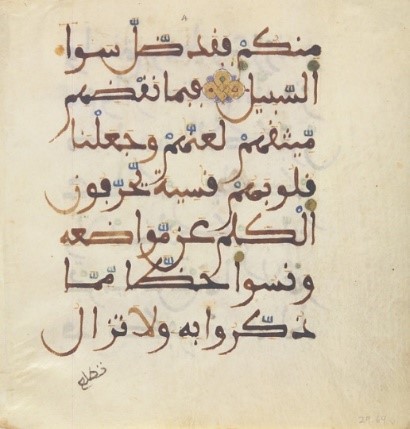The Maghribi Mushaf as a Cultural Tradition of Moroccan People and its Relevance from Occasional Times
DOI:
https://doi.org/10.47453/eduprof.v5i2.234Keywords:
Maghribi Mushaf, Cultural Tradition of Moroccan People, RelevanceAbstract
The Maghreb manuscripts have great cultural significance and are a valuable component of the nation's heritage. They are considered to represent Morocco's rich cultural heritage and provide an in-depth perspective on the history and culture of the country.. As time goes by, many of these mushafs have been abandoned because with advanced technology, Moroccan people can easily read the Koran digitally without using traditional mushafs. This research is a qualitative descriptive study . The research design used is a library research design where the data sources for this research are national and international books and journals, as well as other library sources. Research techniques are carried out using documentation, namely looking for data about a thing or variable in the form of books, articles and journals. Activities in data analysis include data reduction, data display, and conclusion drawing/verification. The results of this research show that the differences between the Maghreb Mushaf and other Al-Quran editions lie in the script and pronunciation, along with a few more words, graphic variations/basic letters, and vowel variants. To read the Mushaf of the Maghreb, one must know the script, understand how to pronounce it, enroll in a Koran school, hear recitation, and practice frequently. By using this strategy, a person can become a better reader and understand the Koran more deeply. Use of the Maghreb Script Evolved Over Time The Maghreb can be traced back to its creation during the Islamic invasion and its subsequent devolution and refinement under several sultans. Maghreb manuscripts are currently preserved and digitized in large numbers, and this provides an invaluable learning opportunity for academics and researchers. The implication of the results of this research is that reading the Koran using a traditional mushaf does not mean backwardness, but is part of preserving culture and following the guidance taught by the Prophet Muhammad
References
Ahmed Waleed S. 2014. A Guide for Studying Arabic and Quran in Morocco. MuslimMatters.org : Morocco https://muslimmatters.org/2014/01/31/guide-studying-arabic-quran-morocco/
Aglan, Amer, ‘Moroccan Mus’ Haf at Abi Mohamed Al-Morjani Mosque in Tunisia-First’ <https://aaciaegypt.com/wp-content/uploads/2021/10/Moroccan-Mushaf-at-Abi-Mohamed-Al-Morjani-Mosque-in-Tunisia-first-published.pdf> [accessed 23 October 2023]
Bencherifa, Mohamed, ‘The Conservation of Manuscripts in Morocco’, in The Conservation and Preservation of Islamic Manuscripts: Proceedings of the Third Conference of Al-Furqan Islamic Heritage Foundation, 18th-19th November 1995, 1996, pp. 21–27
Bongianino, Umberto, ‘Vehicles of Cultural Identity: Some Thoughts on Maghribi Scripts and Manuscripts in the Mashriq’, Studies in the History and Culture of the Middle East, 2021, 455
Boujdad M’kadem, Abdelhamid, and Paul Nieuwenhuysen, ‘Digital Access to Cultural Heritage Material: Case of the Moroccan Manuscripts’, Collection Building, 29.4 (2010), 137–41
Buskens, LPHM, ‘Paper Worlds. A Nesrani Ethnographer Entering the Manuscript Trade in Morocco’, Pratiquer Les Sciences Sociales Au Maghreb. Textes Pour Driss Mansouri, 2014, 239–65
Cohen, Anouk, ‘Exporter «l’islam Marocain»’, AFRIQUE (S), 16
Ekhtiar, Maryam & Cohen, Julia. 2014. Early Qur’ans (8th–Early 13th Century). The Met Fifth Avenue : New York
Ekinci, Ekrem Buğra. 2017. History of the compilation of Quran. https://www.dailysabah.com/feature/2017/06/02/history-of-the-compilation-of-quran
Gilchrist, John. 2018. The Quran: The Scripture of Islam, Chapter 5: The Compilation of the Text of the Quran. https://truthnet.org/islam/Qurangil5.html
Green, Samuel, ‘The Different Arabic Versions of the Qur’an’, Answering Islam. Last Modified March, 7 (2016) <https://religion.antropo.es/estudios/seminario/materiales/Green.Samuel_The-different-arabic-versions-of-the-Quran.pdf> [accessed 23 October 2023]
Hendrickson, Jocelyn, ‘A Guide to Arabic Manuscript Libraries in Morocco, with Notes on Tunisia, Algeria, Egypt, and Spain’, MELA Notes, 81, 2008, 15–88
Newhart, Michelle, and Mildred L. Patten, ‘Understanding Research Methods: An Overview of the Essentials’, 2023 <https://books.google.com/books?hl=en&lr=&id=EaS_EAAAQBAJ&oi=fnd&pg=PT9&dq=This+research+method+is+to+explain+the+content+of+certain+material,+information+or+readings+in+detail+and+also+in+depth&ots=zov3v_i7J-&sig=ovHmOSWub9FkF73YxPSCG3sMSWw> [accessed 23 October 2023]
Rohmah, Hajar Nur, ‘KAJIAN RASM AL-QUR’AN (Perbandingan Antara Mushaf Standar Indonesia Dan Mushaf Maroko)’, 2020 <http://e-repository.perpus.uinsalatiga.ac.id/8200/> [accessed 1 November 2023]
Van den Boogert, Nico, Some Notes on Maghribi Script, 1989

























